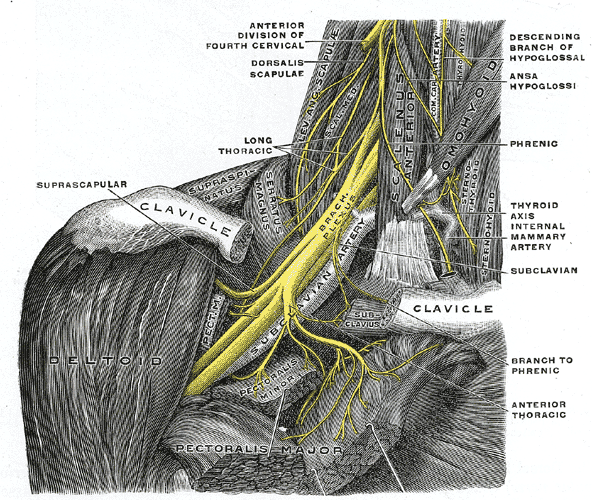Injury Spotlight: Dorsal Scapular Neuropathy
/The brachial plexus viewed from the front.
Non-pharmacological therapeutic interventions are being embraced by the medical community because they are often simple to carry out, economical, and have relatively minor side effects.
One non-pharmacological treatment approach that is used to manage persistent pain is manual nerve mobilizations. The most recent meta-analysis on the topic published in The Journal of Orthopaedic & Sports Physical Therapy suggests that nerve mobilizations are useful for patients with back and neck pain (Basson et al. 2017).
Nerve Mobilizations Are Used To Assess & Treat Irritated Peripheral Nerves
Neurovascular bundles may be exposed to mechanical irritation at many different points. Prolonged irritation may result in the release of inflammatory mediators, known as “inflammatory soup”. In some cases of peripheral nerve inflammation may contribute to ongoing symptoms without overt nerve damage. In these cases five minutes of passive mobilization may help to diminish intraneural edema and/or pressure. This will have a modulatory affect on peripheral and central processes.
In longer standing cases of ongoing inflammation the development of fibrosis, may contribute to peripheral nerve dysfunction. If implemented early the application manual therapy that may attenuate tissue fibrosis and restore motility of peripheral nerves (Bove et al. 2016).
The Complex Clinical Picture of Musculoskeletal Pain
The responses to nerve mobilizations are multifactorial - physiological and psychological factors interplay in a complex manner. A biopsychosocial framework is a practical approach for investigating the complex interplay between massage therapy and the determinants of health, and pain.
A treatment plan should be implemented based on patient-specific assessment findings and patient tolerance. Structures to keep in mind while assessing and treating patients suffering from back and neck pain may include neurovascular structures and investing fascia of:
• Levator Scapula
• Rhomboids
• Trapezius
More to Explore
Basson, A., Olivier, B., Ellis, R., Coppieters, M., Stewart, A., Mudzi, W. (2017). The Effectiveness of Neural Mobilization for Neuro-Musculoskeletal Conditions: A Systematic Review and Meta-Analysis. J Orthop Sports Phys Ther.
https://www.ncbi.nlm.nih.gov/pubmed/28704626
Bove, G.M., Harris, M.Y., Zhao, H., Barbe, M.F. (2016). Manual therapy as an effective treatment for fibrosis in a rat model of upper extremity overuse injury. J Neurol Sci.
https://www.ncbi.nlm.nih.gov/pubmed/26810536
Chang, K.V., Lin, C.P., ... Özçakar, L. (2017). Sonographic tracking of trunk nerves: essential for ultrasound-guided pain management and research. J Pain Res. (OPEN ACCESS)
https://www.ncbi.nlm.nih.gov/pubmed/28115867
Muir, B. (2017). Dorsal scapular nerve neuropathy: a narrative review of the literature. J Can Chiropr Assoc. (OPEN ACCESS)
https://www.ncbi.nlm.nih.gov/pubmed/28928496
Schmid, A.B., Nee, R.J., Coppieters, M.W. (2013). Reappraising entrapment neuropathies--mechanisms, diagnosis and management. Man Ther.
https://www.ncbi.nlm.nih.gov/pubmed/24008054
Sultan, H.E., Younis El-Tantaw,i G.A. (2013). Role of dorsal scapular nerve entrapment in unilateral interscapular pain. Arch Phys Med Rehabil.
https://www.ncbi.nlm.nih.gov/pubmed/23220342


